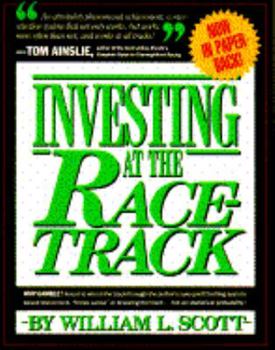Investing at the Racetrack
Select Format
Select Condition 
Book Overview
A great read for any enthusiast! This description may be from another edition of this product.
Format:Paperback
Language:English
ISBN:0671630172
ISBN13:9780671630171
Release Date:August 1986
Publisher:Simon & Schuster
Length:288 Pages
Weight:0.90 lbs.
Dimensions:0.7" x 7.3" x 9.2"
Related Subjects
Games Horses Humor & Entertainment Puzzles & Games Racing Sports & Outdoors Sports & RecreationCustomer Reviews
5 ratings
Investing at the Race Track
Published by Thriftbooks.com User , 15 years ago
The book makes scense, many typos and some of the math doesn't "add up". I'm glad I have it.
Scott's Work is a Classic
Published by Thriftbooks.com User , 16 years ago
William Scott has presented a logical and conservative way to make money at the track. His ability times are brilliant and show us why one horse who runs 1:12 for 6 furlongs has superior class to another horse running the identical time. Combined with his factors on form, it's a winning combination.
Best Handicapping book ever written
Published by Thriftbooks.com User , 16 years ago
This is easily the best horseplaying book I've ever read, and brother, I've read a ton of 'em. Really, it's the only guide I've ever used that works at all. Its principles and betting rules are easy to understand and implement. Since it incorporates the two basic elements in the game that handicappers are forever trying to quantify-pace(or class) and speed-into one factor that he calls "internal ability time" it will make epiphanal sense to any veteran railbird. Anyone who has spent hours perusing every aspect and measurable available in the densely numbered Past Performance Charts will appreciate the simplicity of Mr. Scott's approach. Anybody who can do basic elementary school subtraction and addition and can afford a two dollar calculator can go to the track or OTB 20 min. before post time and easily handicap each race on the card before they're run. Unless you're a dolt it shouldn't take you more than 15 min. to figure a race out. However, it is important that you follow his selection rules to the letter, which means you will come across some races which simply are not bettable. If you have the will power to NOT bet races that are too uncertain, you're three-quarters of the way to becoming a successful handicapper anyway. Go ahead and try it yourself. Put his theory to the test. Read the book and go out and try some $2 win and place bets. Win/Place is all he suggests for his program. These are the only bets that a longtime player can steadily make money at. He also suggests some money management strategies for your bankroll which are commonsense--but that does seem to be a commodity that is in short supply. Your % return on this method will be better than the better mutual funds. You should in the long run earn somewhere between 10% and 20% but you gotta be willing and available to sit around a betting parlor for several hours a day in the company of degenerate ill-informed blabber-mouthed gamblers which can fray one's nerves. Personally it all drives me nuts but I am thousands of dollars ahead in my horse betting ventures.
Easy Reading
Published by Thriftbooks.com User , 24 years ago
Simply put, this book actually does what it says. I won't go so far as to say that it is safer than the stock market. I will say that after reading this book and studying the formulas, that I had the same results (or better) when I took a vacation and spent 2 weeks actually betting at the track, than the author did during his week at the track that he describes in his book. The book tells you how to figure out the speed, endurance and stamina of a horse to see if he has what it takes to be up at the front when the finish line comes rolling around. I have to say that even if you don't believe what he is selling, and even if you don't follow all his little rules, the major tips he gives you in this book will definitely help out the novice handicapper and make a day at the racetrack much more fun. I mean why not, winning money is more fun than losing money. Right?My average was on $20.00 bets. I made $70.00 per day per track bet. My worst day I lost $80.00. My best day I made $700.00Good Luck
Can playing the ponies be viewed as an investment strategy?
Published by Thriftbooks.com User , 27 years ago
The author's premise -- that placing bets at the horse track can be as reliable as investing in the stock market -- may be a bit hard to swallow at first... but handicapper William Scott makes the concept appear quite plausible. Scott shows a refreshing willingness to break with established traditions as he provides the racegoer with a well-explained handicapping method that attempts to remove "luck" from the equation. Readers new to racing will gain valuable insights into the science and art of the sport, while experienced bettors will appreciate the fresh perspective on the "accepted" methods of rating horses and their past performances. The methods detailed in the first half of the book are explained in easy-to-follow detail, supplimented by charts reprinted from various regional editions of the bible of the racing industry, the "Daily Racing Form." While the examples and calculations are explained in easy-to-understand terms, Scott never talks down to his audience -- even the experienced horseman won't be bored. The last half of the book, which shows Scott's methods in use in each race over a typical week at Belmont, serves to cement the lessons learned. Experienced handicappers may shudder at some of Scott's play-it-safe suggestions, and businesspeople with their 401(k) statements may roll their eyes at the idea of blowing money on the ponies, but both should put "Investing at the Racetrack" to the test. After all... it's only money...






